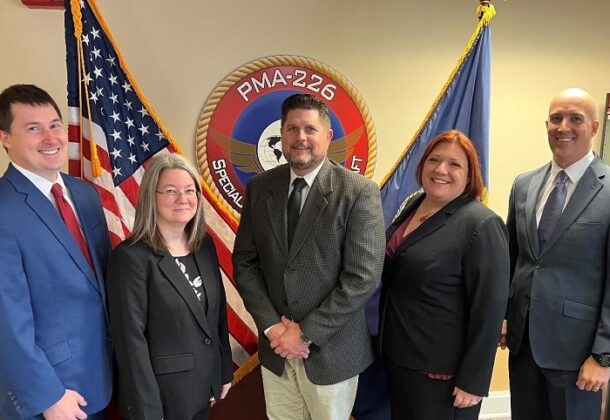PMA-226 Adversary Team Wins DoD Award

The US Navy’s Specialized and Proven Aircraft program office (PMA-226) Adversary Aircraft Team was awarded a DoD Acquisition Workforce Award. Team members are Jesse Steel, left, Lisa Gaskins, Boyd Forsythe, Angela McClure, and Pete Schwartz.
The US Navy’s Specialized and Proven Aircraft Program Office’s Adversary Aircraft Team won the DoD Acquisition Workforce Award for Flexibility in Contracting last month during a virtual ceremony with senior leadership.
The Naval Air Systems Command’s PMA-226 Adversary Aircraft Team employed a novel strategy to modernize Navy and Marine Corps F-5 aircraft by combining an Other Transaction Authority contracting approach while leveraging existing commercial technology and an abbreviated test program to increase affordability, capability, and safety.
“Employing one of NAVAIR’s first OTAs combined with a partnership with industry, this team’s unique strategy will provide a fleet of upgraded, safe, and modernized adversary aircraft, providing the realistic and relevant tactical training that our aviators need to win in the high-end fight for years to come,” said CAPT Gregory Sutton, PMA-226 program manager.
The F-5 provides organic red air adversary support for naval aviation training, but the age of the aircraft and system limitations were reducing the F-5’s ability to keep pace with modern technology inherent in current tactical platforms. To meet the Navy and Marine Corps requirement to increase fleet adversary training capacity with high-altitude tactical fighters, the team employed an OTA to identify an industry partner that previously integrated upgrades on its own privately owned F-5 fleet of aircraft. The OTA approach reduced procurement schedule time that was originally estimated to take 22 months down to seven months.
The team originally estimated the modernization project to cost more than $65 million with a 36-month design and development phase, but by leveraging the industry partner’s previous investments and lessons-learned, additional design and development was unnecessary. The team delivered the first two prototype F-5N aircraft with new digital glass cockpits and other new capabilities for $14.3 million, a savings of more than $50 million.
“PMA-226’s Adversary Team challenged norms to tailor the program requirements using a blend of commercial solutions and the lessons learned by our industry partners with a focus on desired outcomes and taking measured risks,” said Boyd Forsythe, PMA-226 F-5 Adversary team lead
The team accepted measured risk in creating a new, abbreviated test approach that involved both industry and fleet adversary operators for live input instead of formal test events, which ensured both adversary communities could directly interpret and inform test findings and acceptance using adversary pilot employment expertise, saving months of test time.
“Testing at the aircraft modification facility enabled immediate test-fix-fly and avoided months of additional test, paying dividends across communications, cybersecurity, and cockpit lighting tests; test at the modification site allowed for mitigation of challenges in near-real time,” said Andy Wilkinson, PMA-226 principal deputy program manager.
The team’s approach laid the foundation for decades of service life extension for the entire F-5 fleet as it enables the repatriation of 22 former Swiss F-5E/F aircraft, which when combined with the modernization approach the team developed, will mitigate the capacity and capability gaps across Navy and Marine Corps tactical high-altitude training.
This article was provided by NAVAIR News.























